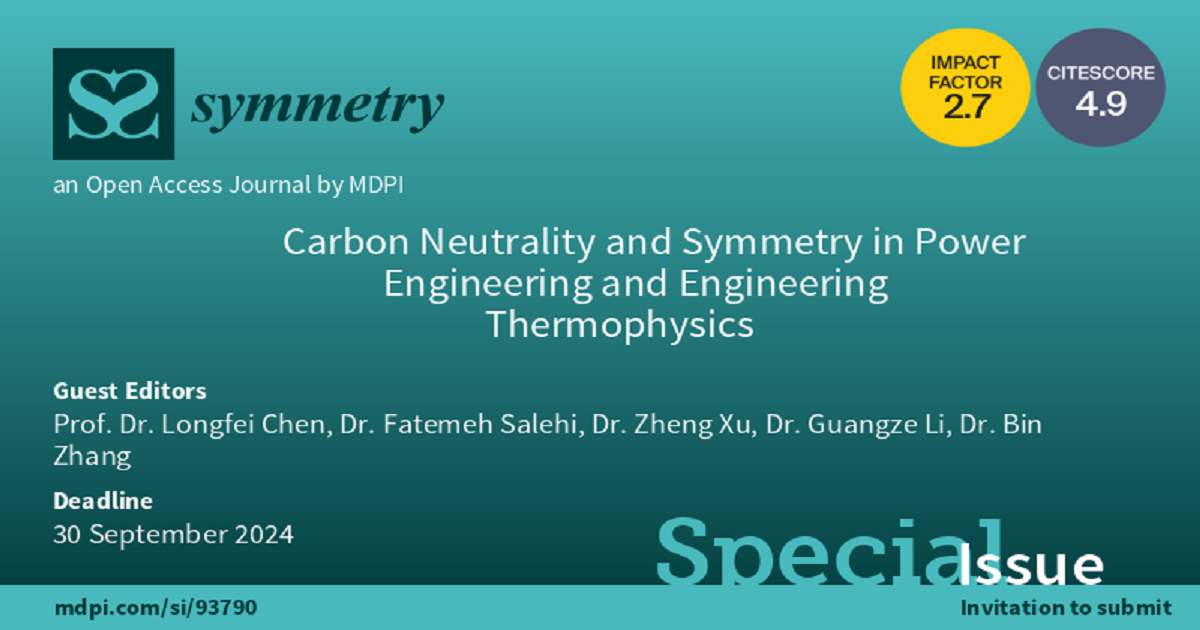Carbon Neutrality and Symmetry in Power Engineering and Engineering Thermophysics
A special issue of Symmetry (ISSN 2073-8994). This special issue belongs to the section "Engineering and Materials".
Deadline for manuscript submissions: 30 September 2024 | Viewed by 16709

Special Issue Editors
Interests: engineering thermophysics; environmental science and engineering
Special Issues, Collections and Topics in MDPI journals
Interests: computational fluid dynamics (CFD); multiphase flows; combustion modelling
Special Issues, Collections and Topics in MDPI journals
Interests: aerospace engine; engineering thermophysics
Special Issues, Collections and Topics in MDPI journals
Interests: combustion; engineering thermophysics
Special Issue Information
Dear Colleagues,
Carbon neutrality and symmetry in power engineering and engineering thermophysics is a hot research topic receiving much attention, and it is rather significant in the development of power systems such as aero-engines and internal combustion engines. In response to global climate change, “carbon peak” and “carbon neutral” have become popular keywords. As one of the main contributors of carbon emissions, power systems are confronted with great challenges in terms of their energy conservation and emissions reduction. For example, improving power system efficiency and developing green alternative fuels are essential ways to reduce carbon emissions. In addition, the symmetrical design of power system structures has important influences on carbon neutrality, as do symmetry or asymmetric fluid properties and lightweight structure, with numerous studies exploring these topics in an attempt to address many novel questions. Given the strict requirements of carbon emission, a breakthrough is needed in the low-carbon technologies of power systems. Therefore, discussing and summarizing the latest outstanding research on carbon neutrality and symmetry in power engineering and engineering thermophysics is of great significance.
The main goal of this Special Issue is to present a collection of manuscripts focused on the frontier research and future challenges of carbon neutrality and symmetry in power engineering and engineering thermophysics. Relevant topics include, but are not limited to:
- Carbon neutrality and sustainable alternative fuels
- Aero-engine carbon neutrality and symmetry
- Carbon neutral technologies for internal combustion engines
- Combustion carbon neutral and symmetry
- Multiphase flow carbon neutral and symmetry
- Carbon neutral and symmetry in heat and mass transfer
- Airworthiness carbon neutrality and symmetry
- Particle measurement and characterization in carbon neutrality and symmetry
- Interdisciplinary issues in carbon neutrality and symmetry
You are also welcome to present your work at “The 1st International Conference on Aerospace Power Engineering and Engineering Thermophysics, Zhongfa Aviation University (APEET, October 2022, Hangzhou, China)” and “Symposium on Transportation Energy and Intelligent Power, (TEIP, Chinese Society for Internal Combustion Engines, October 2022, Beijing, China)”.
Prof. Dr. Longfei Chen
Dr. Fatemeh Salehi
Dr. Zheng Xu
Dr. Guangze Li
Dr. Bin Zhang
Guest Editors
Manuscript Submission Information
Manuscripts should be submitted online at www.mdpi.com by registering and logging in to this website. Once you are registered, click here to go to the submission form. Manuscripts can be submitted until the deadline. All submissions that pass pre-check are peer-reviewed. Accepted papers will be published continuously in the journal (as soon as accepted) and will be listed together on the special issue website. Research articles, review articles as well as short communications are invited. For planned papers, a title and short abstract (about 100 words) can be sent to the Editorial Office for announcement on this website.
Submitted manuscripts should not have been published previously, nor be under consideration for publication elsewhere (except conference proceedings papers). All manuscripts are thoroughly refereed through a single-blind peer-review process. A guide for authors and other relevant information for submission of manuscripts is available on the Instructions for Authors page. Symmetry is an international peer-reviewed open access monthly journal published by MDPI.
Please visit the Instructions for Authors page before submitting a manuscript. The Article Processing Charge (APC) for publication in this open access journal is 2400 CHF (Swiss Francs). Submitted papers should be well formatted and use good English. Authors may use MDPI's English editing service prior to publication or during author revisions.









